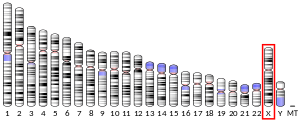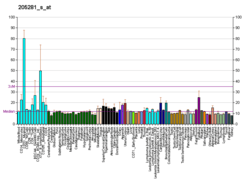PIGA
Phosphatidylinositol N-acetylglucosaminyltransferase subunit A (PIG-A, or phosphatidylinositol glycan, class A) is the catalytic subunit of the phosphatidylinositol N-acetylglucosaminyltransferase enzyme, which in humans is encoded by the PIGA gene.[5][6]
This gene encodes a protein required for synthesis of N-acetylglucosaminyl phosphatidylinositol (GlcNAc-PI), the first intermediate in the biosynthetic pathway of GPI anchor. The GPI anchor is a glycolipid found on many blood cells and serves to anchor proteins to the cell surface. Paroxysmal nocturnal hemoglobinuria, an acquired hematologic disorder, has been shown to result from somatic mutations in this gene. Alternate splice variants have been characterized.[6]
Multiple Congenital Anomalies-Hypotonia-Seizures syndrome type 2 (MCAHS2), also known as PIGA-CDG or PIGA deficiency, has been shown to result from germline mutations in the PIGA gene.[7]
Interactions
PIGA has been shown for interact with PIGQ.[8]
References
- GRCh38: Ensembl release 89: ENSG00000165195 - Ensembl, May 2017
- GRCm38: Ensembl release 89: ENSMUSG00000031381 - Ensembl, May 2017
- "Human PubMed Reference:". National Center for Biotechnology Information, U.S. National Library of Medicine.
- "Mouse PubMed Reference:". National Center for Biotechnology Information, U.S. National Library of Medicine.
- Takeda J, Miyata T, Kawagoe K, Iida Y, Endo Y, Fujita T, Takahashi M, Kitani T, Kinoshita T (Jun 1993). "Deficiency of the GPI anchor caused by a somatic mutation of the PIG-A gene in paroxysmal nocturnal hemoglobinuria". Cell. 73 (4): 703–11. doi:10.1016/0092-8674(93)90250-T. PMID 8500164.
- "Entrez Gene: PIGA phosphatidylinositol glycan anchor biosynthesis, class A (paroxysmal nocturnal hemoglobinuria)".
- "OMIM Entry 311770 - PHOSPHATIDYLINOSITOL GLYCAN ANCHOR BIOSYNTHESIS CLASS A PROTEIN; PIGA". www.omim.org. Retrieved 2019-04-19.
- Watanabe, R; Inoue N; Westfall B; Taron C H; Orlean P; Takeda J; Kinoshita T (Feb 1998). "The first step of glycosylphosphatidylinositol biosynthesis is mediated by a complex of PIG-A, PIG-H, PIG-C and GPI1". EMBO J. 17 (4): 877–85. doi:10.1093/emboj/17.4.877. ISSN 0261-4189. PMC 1170437. PMID 9463366.
Further reading
- Brodsky RA, Hu R (2007). "PIG-A mutations in paroxysmal nocturnal hemoglobinuria and in normal hematopoiesis". Leuk. Lymphoma. 47 (7): 1215–21. doi:10.1080/10428190600555520. PMID 16923549.
- Miyata T, Takeda J, Iida Y, et al. (1993). "The cloning of PIG-A, a component in the early step of GPI-anchor biosynthesis". Science. 259 (5099): 1318–20. Bibcode:1993Sci...259.1318M. doi:10.1126/science.7680492. PMID 7680492.
- Yu J, Nagarajan S, Ueda E, et al. (1994). "Characterization of alternatively spliced PIG-A transcripts in normal and paroxysmal nocturnal hemoglobinuria cells". Braz. J. Med. Biol. Res. 27 (2): 195–201. PMID 8081230.
- Bessler M, Hillmen P, Longo L, et al. (1994). "Genomic organization of the X-linked gene (PIG-A) that is mutated in paroxysmal nocturnal haemoglobinuria and of a related autosomal pseudogene mapped to 12q21". Hum. Mol. Genet. 3 (5): 751–7. doi:10.1093/hmg/3.5.751. PMID 8081362.
- Ware RE, Rosse WF, Howard TA (1994). "Mutations within the Piga gene in patients with paroxysmal nocturnal hemoglobinuria". Blood. 83 (9): 2418–22. PMID 8167330.
- Iida Y, Takeda J, Miyata T, et al. (1994). "Characterization of genomic PIG-A gene: a gene for glycosylphosphatidylinositol-anchor biosynthesis and paroxysmal nocturnal hemoglobinuria". Blood. 83 (11): 3126–31. PMID 8193350.
- Bessler M, Mason PJ, Hillmen P, et al. (1994). "Paroxysmal nocturnal haemoglobinuria (PNH) is caused by somatic mutations in the PIG-A gene". EMBO J. 13 (1): 110–7. PMC 394784. PMID 8306954.
- Savoia A, Ianzano L, Lunardi C, et al. (1996). "Identification of three novel mutations in the PIG-A gene in paroxysmal nocturnal haemoglobinuria (PNH) patients". Hum. Genet. 97 (1): 45–8. doi:10.1007/BF00218831. PMID 8557259.
- Watanabe R, Kinoshita T, Masaki R, et al. (1996). "PIG-A and PIG-H, which participate in glycosylphosphatidylinositol anchor biosynthesis, form a protein complex in the endoplasmic reticulum". J. Biol. Chem. 271 (43): 26868–75. doi:10.1074/jbc.271.43.26868. PMID 8900170.
- Watanabe R, Inoue N, Westfall B, et al. (1998). "The first step of glycosylphosphatidylinositol biosynthesis is mediated by a complex of PIG-A, PIG-H, PIG-C and GPI1". EMBO J. 17 (4): 877–85. doi:10.1093/emboj/17.4.877. PMC 1170437. PMID 9463366.
- Nafa K, Bessler M, Castro-Malaspina H, et al. (1999). "The spectrum of somatic mutations in the PIG-A gene in paroxysmal nocturnal hemoglobinuria includes large deletions and small duplications". Blood Cells Mol. Dis. 24 (3): 370–84. doi:10.1006/bcmd.1998.0203. PMID 10087994.
- Watanabe R, Murakami Y, Marmor MD, et al. (2000). "Initial enzyme for glycosylphosphatidylinositol biosynthesis requires PIG-P and is regulated by DPM2". EMBO J. 19 (16): 4402–11. doi:10.1093/emboj/19.16.4402. PMC 302040. PMID 10944123.
- Yoon JH, Cho HI, Park SS, et al. (2002). "Mutation analysis of the PIG-A gene in Korean patients with paroxysmal nocturnal haemoglobinuria". J. Clin. Pathol. 55 (6): 410–3. doi:10.1136/jcp.55.6.410. PMC 1769670. PMID 12037021.
- Nagakura S, Ishihara S, Dunn DE, et al. (2002). "Decreased susceptibility of leukemic cells with PIG-A mutation to natural killer cells in vitro". Blood. 100 (3): 1031–7. doi:10.1182/blood.V100.3.1031. PMID 12130519.
- Kai T, Shichishima T, Noji H, et al. (2003). "Phenotypes and phosphatidylinositol glycan-class A gene abnormalities during cell differentiation and maturation from precursor cells to mature granulocytes in patients with paroxysmal nocturnal hemoglobinuria". Blood. 100 (10): 3812–8. doi:10.1182/blood.V100.10.3812. PMID 12411324.
- Mortazavi Y, Merk B, McIntosh J, et al. (2003). "The spectrum of PIG-A gene mutations in aplastic anemia/paroxysmal nocturnal hemoglobinuria (AA/PNH): a high incidence of multiple mutations and evidence of a mutational hot spot". Blood. 101 (7): 2833–41. doi:10.1182/blood-2002-07-2095. PMID 12424196.
- Strausberg RL, Feingold EA, Grouse LH, et al. (2003). "Generation and initial analysis of more than 15,000 full-length human and mouse cDNA sequences". Proc. Natl. Acad. Sci. U.S.A. 99 (26): 16899–903. Bibcode:2002PNAS...9916899M. doi:10.1073/pnas.242603899. PMC 139241. PMID 12477932.
- Ota T, Suzuki Y, Nishikawa T, et al. (2004). "Complete sequencing and characterization of 21,243 full-length human cDNAs". Nat. Genet. 36 (1): 40–5. doi:10.1038/ng1285. PMID 14702039.
- Gerhard DS, Wagner L, Feingold EA, et al. (2004). "The status, quality, and expansion of the NIH full-length cDNA project: the Mammalian Gene Collection (MGC)". Genome Res. 14 (10B): 2121–7. doi:10.1101/gr.2596504. PMC 528928. PMID 15489334.




